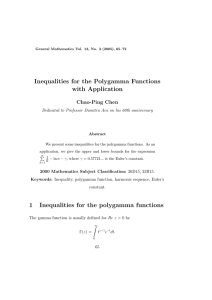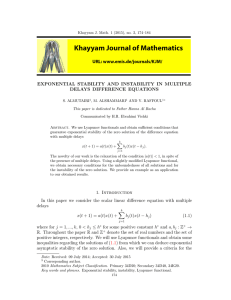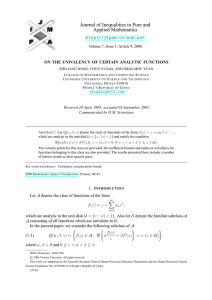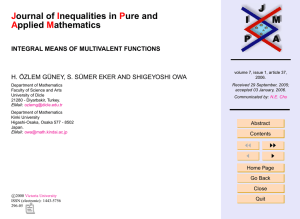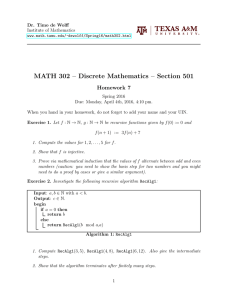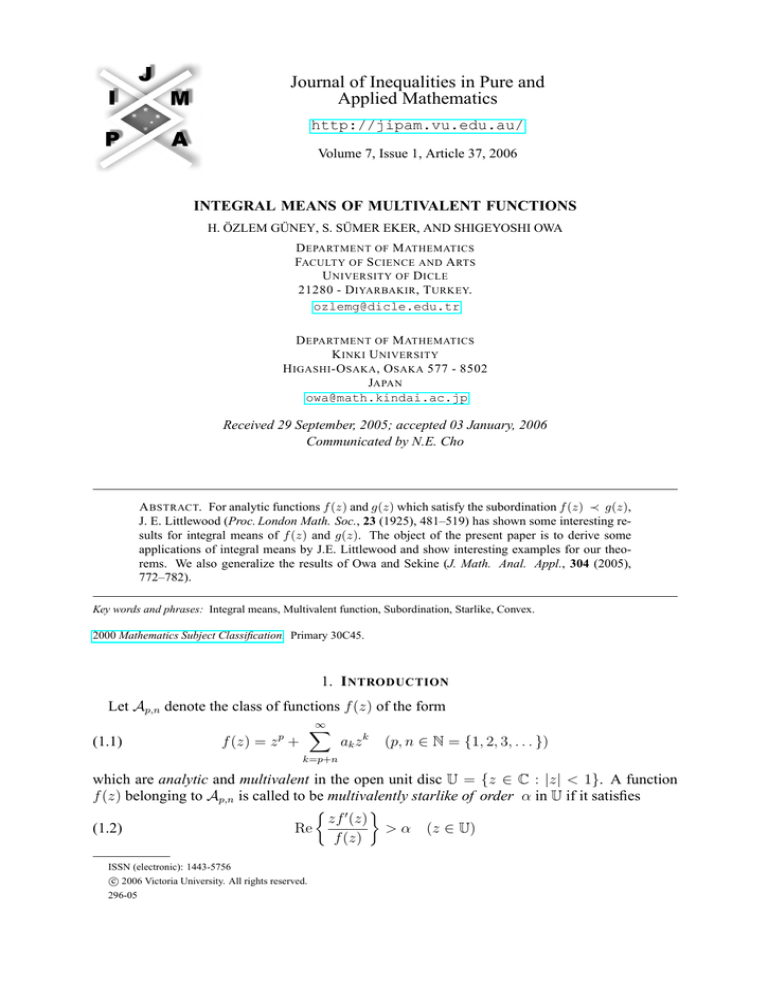
Journal of Inequalities in Pure and
Applied Mathematics
http://jipam.vu.edu.au/
Volume 7, Issue 1, Article 37, 2006
INTEGRAL MEANS OF MULTIVALENT FUNCTIONS
H. ÖZLEM GÜNEY, S. SÜMER EKER, AND SHIGEYOSHI OWA
D EPARTMENT OF M ATHEMATICS
FACULTY OF S CIENCE AND A RTS
U NIVERSITY OF D ICLE
21280 - D IYARBAKIR , T URKEY.
ozlemg@dicle.edu.tr
D EPARTMENT OF M ATHEMATICS
K INKI U NIVERSITY
H IGASHI -O SAKA , O SAKA 577 - 8502
JAPAN
owa@math.kindai.ac.jp
Received 29 September, 2005; accepted 03 January, 2006
Communicated by N.E. Cho
A BSTRACT. For analytic functions f (z) and g(z) which satisfy the subordination f (z) ≺ g(z),
J. E. Littlewood (Proc. London Math. Soc., 23 (1925), 481–519) has shown some interesting results for integral means of f (z) and g(z). The object of the present paper is to derive some
applications of integral means by J.E. Littlewood and show interesting examples for our theorems. We also generalize the results of Owa and Sekine (J. Math. Anal. Appl., 304 (2005),
772–782).
Key words and phrases: Integral means, Multivalent function, Subordination, Starlike, Convex.
2000 Mathematics Subject Classification. Primary 30C45.
1. I NTRODUCTION
Let Ap,n denote the class of functions f (z) of the form
(1.1)
∞
X
f (z) = z p +
ak z k
(p, n ∈ N = {1, 2, 3, . . . })
k=p+n
which are analytic and multivalent in the open unit disc U = {z ∈ C : |z| < 1}. A function
f (z) belonging to Ap,n is called to be multivalently starlike of order α in U if it satisfies
0 zf (z)
(1.2)
Re
> α (z ∈ U)
f (z)
ISSN (electronic): 1443-5756
c 2006 Victoria University. All rights reserved.
296-05
2
H. Ö ZLEM G ÜNEY , S. S ÜMER E KER ,
AND
S HIGEYOSHI OWA
for some α(0 5 α < p). A function f (z) ∈ Ap,n is said to be multivalently convex of order α
in U if it satisfies
zf 00 (z)
(1.3)
Re 1 + 0
> α (z ∈ U)
f (z)
∗
for some α(0 5 α < p). We denote by Sp,n
(α) and Kp,n (α) the classes of functions f (z) ∈ Ap,n
which are multivalently starlike of order α in U and multivalently convex of order α in U,
respectively. We note that
f (z) ∈ Kp,n (α) ⇔
zf 0 (z)
∗
∈ Sp,n
(α).
p
∗
For functions f (z) belonging to the classes Sp,n
(α) and Kp,n (α), Owa [4] has shown the following coefficient inequalities.
Theorem 1.1. If a function f (z) ∈ Ap,n satisfies
∞
X
(1.4)
(k − α)|ak | 5 p − α
k=p+n
∗
for some α (0 5 α < p), then f (z) ∈ Sp,n
(α).
Theorem 1.2. If a function f (z) ∈ Ap,n satisfies
∞
X
(1.5)
k(k − α)|ak | 5 p − α
k=p+n
for some α(0 5 α < p), then f (z) ∈ Kp,n (α).
For analytic functions f (z) and g(z) in U, f (z) is said to be subordinate to g(z) in U if
there exists an analytic function w(z) in U such that w(0) = 0, |w(z)| < 1 (z ∈ U), and
f (z) = g(w(z)). We denote this subordination by
f (z) ≺ g(z) (cf. Duren [2]).
To discuss our problems for integral means of multivalent functions, we have to recall here the
following result due to Littlewood [3].
Theorem 1.3. If f (z) and g(z) are analytic in U with f (z) ≺ g(z), then for µ > 0 and z = reiθ
(0 < r < 1),
Z 2π
Z 2π
µ
(1.6)
|f (z)| dθ 5
|g(z)|µ dθ.
0
0
Applying Theorem 1.3 by Littlewood [3], Owa and Sekine [5] have considered some integral
means inequalities for certain analytic functions. In the present paper, we discuss the integral
means inequalities for multivalent functions which are the generalization of the paper by Owa
and Sekine [5].
2. I NTEGRAL M EANS I NEQUALITIES FOR f (z) AND g(z)
In this section, we discuss the integral means inequalities for f (z) ∈ Ap,n and g(z) defined
by
(2.1)
g(z) = z p + bj z j + b2j−p z 2j−p
(j = n + p).
We first derive
J. Inequal. Pure and Appl. Math., 7(1) Art. 37, 2006
http://jipam.vu.edu.au/
I NTEGRAL M EANS OF M ULTIVALENT F UNCTIONS
3
Theorem 2.1. Let f (z) ∈ Ap,n and g(z) be given by (2.1). If f (z) satisfies
∞
X
(2.2)
|ak | 5 |b2j−p | − |bj |
(|bj | < |b2j−p |)
k=p+n
and there exists an analytic function w(z) such that
2(j−p)
b2j−p (w(z))
j−p
+ bj (w(z))
−
∞
X
ak z k−p = 0,
k=p+n
then for µ > 0 and z = reiθ (0 < r < 1),
Z 2π
Z
µ
|f (z)| dθ 5
0
2π
|g(z)|µ dθ.
0
Proof. By putting z = reiθ (0 < r < 1), we see that
µ
Z 2π
Z 2π ∞
X
p
ak z k dθ
|f (z)|µ dθ =
z +
0
0
k=p+n
µ
Z 2π ∞
X
k−p pµ
ak z dθ
=r
1 +
0
k=p+n
and
2π
Z
Z
2π
p
z + bj z j + b2j−p z 2j−p µ dθ
0
Z 2π
pµ
1 + bj z j−p + b2j−p z 2j−2p µ dθ.
=r
µ
|g(z)| dθ =
0
0
Applying Theorem 1.3, we have to show that
∞
X
1+
ak z k−p ≺ 1 + bj z j−p + b2j−p z 2(j−p) .
k=p+n
Let us define the function w(z) by
1+
∞
X
ak z k−p = 1 + bj (w(z))j−p + b2j−p (w(z))2(j−p)
k=p+n
or by
(2.3)
2(j−p)
b2j−p (w(z))
j−p
+ bj (w(z))
−
∞
X
ak z k−p = 0.
k=p+n
Since, for z = 0,
n
o
(w(0))j−p b2j−p (w(0))j−p + bj = 0,
there exists an analytic function w(z) in U such that w(0) = 0.
Next we prove the analytic function w(z) satisfies |w(z)| < 1 (z ∈ U) for
∞
X
|ak | 5 |b2j−p | − |bj |
(|bj | < |b2j−p |) .
k=p+n
J. Inequal. Pure and Appl. Math., 7(1) Art. 37, 2006
http://jipam.vu.edu.au/
4
H. Ö ZLEM G ÜNEY , S. S ÜMER E KER ,
AND
S HIGEYOSHI OWA
By the inequality (2.3), we know that
∞
∞
X
X
2(j−p)
j−p k−p + bj (w(z)) = ak z <
|ak |
b2j−p (w(z))
k=p+n
k=p+n
for z ∈ U, hence
|b2j−p | |w(z)|2(j−p) − |bj | |w(z)|j−p −
(2.4)
∞
X
|ak | < 0.
k=p+n
Letting t = |w(z)|j−p (t = 0) in (2.4), we define the function G(t) by
∞
X
2
G(t) = |b2j−p | t − |bj | t −
|ak | .
k=p+n
If G(1) = 0, then we have t < 1 for G(t) < 0. Indeed we have
G(1) = |b2j−p | − |bj | −
∞
X
|ak | = 0.
k=p+n
that is,
∞
X
|ak | 5 |b2j−p | − |bj | .
k=p+n
Consequently, if the inequality (2.2) holds true, there exists an analytic function w(z) with
w(0) = 0, |w(z)| < 1 (z ∈ U) such that f (z) = g (w(z)). This completes the proof of Theorem
2.1.
Theorem 2.1 gives us the following corollary.
Corollary 2.2. Let f (z) ∈ Ap,n and g(z) be given by (2.1). If f (z) satisfies the conditions of
Theorem 2.1, then for 0 < µ 5 2 and z = reiθ (0 < r < 1)
2π
Z
µ
|f (z)|µ dθ 5 2πrpµ 1 + |bj |2 r2(j−p) + |b2j−p |2 r4(j−p) 2
0
µ
< 2π 1 + |bj |2 + |b2j−p |2 2 .
Further, we have that f (z) ∈ Hq (U ) for 0 < q 5 2, where Hq denotes the Hardy space (cf.
Duren [1]).
Proof. Since,
Z
2π
µ
Z
|g(z)| dθ =
0
J. Inequal. Pure and Appl. Math., 7(1) Art. 37, 2006
2π
µ
|z p |µ 1 + bj z j−p + b2j−p z 2(j−p) dθ,
0
http://jipam.vu.edu.au/
I NTEGRAL M EANS OF M ULTIVALENT F UNCTIONS
5
applying Hölder’s inequality for 0 < µ < 2, we obtain that
Z 2π
2−µ
Z 2π Z 2π
µ2 µ2
2
2
µ
1 + bj z j−p + b2j−p z 2(j−p) |g(z)|µ dθ 5
(|z p |µ ) 2−µ dθ
dθ
0
0
=
r
0
2pµ
2−µ
Z
2−µ
Z
2
2π
dθ
0
2π
1 + bj z j−p + b2j−p z 2(j−p) 2 dθ
µ2
0
n
o 2−µ
µ
2pµ
2 2π 1 + |bj |2 r2(j−p) + |b2j−p |2 r4(j−p) 2
= 2πr 2−µ
µ
= 2πrpµ 1 + |bj |2 r2(j−p) + |b2j−p |2 r4(j−p) 2
µ
< 2π 1 + |bj |2 + |b2j−p |2 2 .
Further, it is easy to see that for µ = 2,
Z 2π
|f (z)|2 dθ 5 2πrpµ 1 + |bj |2 r2(j−p) + |b2j−p |2 r4(j−p)
0
< 2π 1 + |bj |2 + |b2j−p |2 .
From the above, we also have that, for 0 < µ 5 2,
Z 2π
µ
1
sup
|f (z)|µ dθ 5 2πrpµ 1 + |bj |2 + |b2j−p |2 2 < ∞
z∈U 2π 0
which observe that f (z) ∈ H2 (U). Noting that Hq ⊂ Hr (0 < r < q < ∞), we complete the
proof of the corollary.
Example 2.1. Let f (z) ∈ Ap,n satisfy the coefficient inequality (1.4) and
n
εz j + δz 2j−p (|ε| = |δ| = 1)
g(z) = z p +
n+p−α
nε
and b2j−p = δ.
with 0 5 α < p. Note that bj =
n+p−α
By virtue of (1.4), we observe that
∞
X
p−α
n
|ak | ≤
=1−
= |b2j−p | − |bj | .
p+n−α
p+n−α
k=p+n
Therefore, if there exists the function w(z) satisfying the condition in Theorem 2.1, then f (z)
and g(z) satisfy the conditions in Theorem 2.1. Thus we have for 0 < µ 5 2 and z = reiθ
(0 < r < 1),
(
) µ2
2
Z 2π
n
|f (z)|µ dθ 5 2πrpµ 1 +
r2(j−p) + r4(j−p)
p
+
n
−
α
0
(
2 ) µ2
n
< 2π 2 +
.
p+n−α
Using the same technique as in the proof of Theorem 2.1, we also derive
Theorem 2.3. Let f (z) ∈ Ap,n and g(z) be given by (2.1). If f (z) satisfies
(2.5)
∞
X
k|ak | 5 (2j − p)|b2j−p | − j|bj |
(|bj | < |b2j−p |)
k=p+n
J. Inequal. Pure and Appl. Math., 7(1) Art. 37, 2006
http://jipam.vu.edu.au/
6
H. Ö ZLEM G ÜNEY , S. S ÜMER E KER ,
AND
S HIGEYOSHI OWA
and there exists an analytic function w(z) such that
2(j−p)
(2j − p)b2j−p (w(z))
j−p
+ jbj (w(z))
∞
X
−
kak z k−p = 0,
k=p+n
then for µ > 0 and z = reiθ (0 < r < 1)
Z 2π
Z
0
µ
|f (z)| dθ 5
0
2π
|g 0 (z)|µ dθ.
0
Further, with the help of Hölder’s inequality, we have
Corollary 2.4. Let f (z) ∈ Ap,n and g(z) be given by (2.1). If. f (z) satisfies conditions of
Theorem 2.3, then for 0 < µ 5 2 and z = reiθ (0 < r < 1)
Z 2π
µ
|f 0 (z)|µ dθ 5 2πr(p−1)µ p2 + j 2 |bj |2 r2(j−p) + (2j − p)2 |b2j−p |2 r4(j−p) 2
0
µ
< 2π p2 + j 2 |bj |2 + (2j − p)2 |b2j−p |2 2 .
Example 2.2. Let f (z) ∈ Ap,n satisfy the coefficient inequality (1.5) and
g(z) = z p +
n
δ
εz j +
z 2j−p
j(n + p − α)
2j − p
(|ε| = |δ| = 1)
with 0 5 α < p. Then
bj =
nε
j(n + p − α)
and b2j−p =
δ
.
2j − p
Since
∞
X
k|ak | 5
k=p+n
p−α
n
=1−
= (2j − p)|b2j−p | − j|bj |,
p+n−α
p+n−α
if there exists the function w(z) satisfying the condition in Theorem 2.3, then f (z) and g(z)
satisfy the conditions in Theorem 2.3. Thus by Corollary 2.4, we have for 0 < µ 5 2 and
z = reiθ (0 < r < 1),
(
) µ2
2
Z 2π
n
|f 0 (z)|µ dθ 5 2πr(p−1)µ p2 +
r2(j−p) + r4(j−p)
p
+
n
−
α
0
(
2 ) µ2
n
< 2π p2 + 1 +
.
p+n−α
3. I NTEGRAL M EANS I NEQUALITIES FOR f (z) AND h(z)
In this section, we introduce an analytic and multivalent function h(z) defined by
(3.1)
h(z) = z p + bj z j + b2j−p z 2j−p + b3j−2p z 3j−2p
(j = n + p).
For the above function h(z), we show
Theorem 3.1. Let f (z) ∈ Ap,n and h(z) be given by (3.1). If f (z) satisfies
(3.2)
∞
X
|ak | 5 |b3j−2p | − |b2j−p | − |bj |
(|bj | + |b2j−p | < |b3j−2p |)
k=p+n
J. Inequal. Pure and Appl. Math., 7(1) Art. 37, 2006
http://jipam.vu.edu.au/
I NTEGRAL M EANS OF M ULTIVALENT F UNCTIONS
7
and there exists an analytic function w(z) such that
3(j−p)
b3j−2p (w(z))
(3.3)
2(j−p)
j−p
+ b2j−p (w(z))
+ bj (w(z))
−
∞
X
ak z k−p = 0,
k=p+n
then for µ > 0 and z = reiθ (0 < r < 1)
Z 2π
Z
µ
|f (z)| dθ 5
0
2π
|h(z)|µ dθ.
0
Proof. In the same way as in the proof of Theorem 2.1, we have to show that there exists an
analytic function w(z) with w(0) = 0 and |w(z)| < 1 (z ∈ U) such that f (z) = h(w(z)). Note
that this function w(z) is defined by (3.3).
Since, for z = 0,
n
o
j−p
2(j−p)
j−p
(w(0))
b3j−2p (w(0))
+ b2j−p (w(0)) + bj = 0,
we consider w(z) satisfies w(0) = 0.
On the other hand, we have that
3(j−p)
2(j−p)
|b3j−2p ||w(z)|
− |b2j−p ||w(z)|
j−p
− |bj ||w(z)|
−
∞
X
|ak | < 0.
k=n+p
Putting t = |w(z)|j−p (t = 0), we define the function H(t) by
3
∞
X
2
H(t) = |b3j−2p |t − |b2j−p |t − |bj |t −
|ak |.
k=n+p
It follows that H(0) 5 0 and
H 0 (t) = 3|b3j−2p |t2 − 2|b2j−p |t − |bj |.
Since the discriminant of H 0 (t) = 0 is greater than 0, if H 0 (1) = 0, then t < 1 for H(t) < 0.
Therefore, we need the following inequality:
H(1) = |b3j−2p | − |b2j−p | − |bj | −
∞
X
|ak | = 0
k=p+n
or
∞
X
|ak | 5 |b3j−2p | − |b2j−p | − |bj |.
k=p+n
This completes the proof of Theorem 3.1.
Corollary 3.2. Let f (z) ∈ Ap,n and h(z) be given by (3.1). If f (z) satisfies conditions of
Theorem 3.1, then for 0 < µ 5 2 and z = reiθ (0 < r < 1)
Z 2π
µ
|f (z)|µ dθ 5 2πrpµ 1 + |bj |2 r2(j−p) + |b2j−p |2 r4(j−p) + |b3j−2p |2 r6(j−p) 2
0
µ
< 2π 1 + |bj |2 + |b2j−p |2 + |b3j−2p |2 2 .
Proof. Since
Z 2π
µ
Z
|h(z)| dθ =
0
2π
|z p |µ |1 + bj z j−p + b2j−p z 2(j−p) + b3j−2p z 3(j−p) |µ dθ,
0
J. Inequal. Pure and Appl. Math., 7(1) Art. 37, 2006
http://jipam.vu.edu.au/
8
H. Ö ZLEM G ÜNEY , S. S ÜMER E KER ,
AND
S HIGEYOSHI OWA
applying Hölder’s inequality for 0 < µ < 2, we obtain that
Z 2π
|h(z)|µ dθ
0
Z
2π
(|z p |µ )
5
2
2−µ
2−µ
Z
2
2π
2
|1 + bj z j−p + b2j−p z 2(j−p) + b3j−2p z 3(j−p) |µ µ dθ
dθ
0
µ2
0
2−µ
Z
2
2π
Z
2pµ
= r 2−µ
2π
|1 < +bj z
dθ
0
j−p
+ b2j−p z
2(j−p)
+ b2j−2p z
3(j−p) 2
µ2
| dθ
0
n
o 2−µ
µ
2pµ
2 2−µ
2π(1 + |bj |2 r2(j−p) + |b2j−p |2 r4(j−p) + |b3j−2p |2 r6(j−p) ) 2
= 2πr
µ
= 2πrpµ 1 < +|bj |2 r2(j−p) + |b2j−p |2 r4(j−p) + |b3j−2p |2 r6(j−p) 2
µ
< 2π 1 + |bj |2 + |b2j−p |2 + |b3j−2p |2 2 .
Further, we have that f (z) ∈ Hq (U) for 0 < q < 2.
We consider the example for Theorem 3.1.
Example 3.1. Let f (z) ∈ Ap,n satisfy the coefficient inequality (1.4) and
h(z) = z p +
nt
n(1 − t) 2j−p
εz j +
δz
+ σz 3j−2p
p+n−α
p+n−α
(|ε| = |δ| = σ| = 1; 0 5 t 5 1)
with 0 5 α < p. Then
bj =
nt
n(1 − t)
ε, b2j−p =
δ
p+n−α
p+n−α
and b3j−2p = σ.
In view of (1.4), we see that
∞
X
|ak | 5
k=p+n
p−α
p+n−α
n(1 − t)
nt
−
p+n−α p+n−α
= |b3j−2p | − |b2j−p | − |bj |.
=1−
Therefore, if there exists the function w(z) satisfying the condition in Theorem 3.1, then f (z)
and g(z) satisfy the conditions in Theorem 3.1. Thus applying Corollary 3.2, we have for
0 < µ 5 2 and z = reiθ (0 < r < 1),
Z 2π
|f (z)|µ dθ
0
(
5 2πrpµ
1+
nt
p+n−α
(
< 2π
2
2 + (2t − 2t + 1)
2
n(1 − t)
p+n−α
2 ) µ2
.
r2(j−p) +
n
p+n−α
2
) µ2
r4(j−p) + r6(j−p)
Next, we derive
J. Inequal. Pure and Appl. Math., 7(1) Art. 37, 2006
http://jipam.vu.edu.au/
I NTEGRAL M EANS OF M ULTIVALENT F UNCTIONS
9
Theorem 3.3. Let f (z) ∈ Ap,n and h(z) be given by (3.1). If f (z) satisfies
∞
X
(3.4)
k|ak | 5 (3j − 2p)|b3j−2p | − (2j − p)|b2j−p | − j|bj |
k=p+n
(j|bj | + (2j − p)|b2j−p | < (3j − 2p)|b3j−2p |)
and there exists an analytic function w(z) such that
(3j − 2p)b3j−2p (w(z))3(j−p) + (2j − p)b2j−p (w(z))2(j−p)
j−p
+ jbj (w(z))
−
∞
X
kak z k−p = 0,
k=p+n
then for µ > 0 and z = reiθ (0 < r < 1)
Z 2π
Z
0
µ
|f (z)| dθ 5
0
2π
|h0 (z)|µ dθ.
0
Corollary 3.4. Let f (z) ∈ Ap,n and h(z) be given by (3.1). If f (z) satisfies conditions in
Theorem 3.3, then for 0 < µ 5 2 and z = reiθ (0 < r < 1)
Z 2π
|f 0 (z)|µ dθ 5 2πr(p−1)µ p2 + j 2 |bj |2 r2(j−p) + (2j − p)2 |b2j−p |2 r4(j−p)
0
µ
+ (3j − 2p)2 |b3j−2p |2 r6(j−p) 2
µ
< 2π p2 + j 2 |bj |2 + (2j − p)2 |b2j−p |2 + (3j − 2p)2 |b3j−2p |2 2 .
Finally, we show
Example 3.2. Let f (z) ∈ Ap,n satisfy the coefficient inequality (1.5) and
h(z) = z p +
nt
n(1 − t)
σ
εz j +
δz 2j−p +
z 3j−2p
j(p + n − α)
(2j − p)(p + n − α)
3j − 2p
(|ε| = |δ| = |σ| = 1; 0 5 t 5 1)
with 0 5 α < p. Then
nt
n(1 − t)
ε, b2j−p =
δ
p+n−α
(2j − p)(p + n − α)
σ
=
.
3j − 2p
bj =
b3j−2p
and
Since
∞
X
k=p+n
k|ak | 5
p−α
p+n−α
n
p+n−α
= (3j − 2p)|b3j−2p | − (2j − p)|b2j−p | − j|bj |,
=1−
if there exists the function w(z) satisfying the condition in Theorem 3.3, then f (z) and g(z)
satisfy the conditions in Theorem 3.3. Thus by Corollary 3.4, we have for 0 < µ 5 2 and
J. Inequal. Pure and Appl. Math., 7(1) Art. 37, 2006
http://jipam.vu.edu.au/
10
H. Ö ZLEM G ÜNEY , S. S ÜMER E KER , AND S HIGEYOSHI OWA
z = reiθ (0 < r < 1),
Z 2π
|f 0 (z)|µ dθ
0
(
5 2πr(p−1)µ
p2 +
nt
p+n−α
(
< 2π
2
2
p + 1 + (2t − 2t + 1)
2
n(1 − t)
p+n−α
2 ) µ2
.
r2(j−p) +
n
p+n−α
2
) µ2
r4(j−p) + r6(j−p)
Remark 3.5. We have not been able to prove that the analytic function w(z) satisfying each
condition of the theorems in this paper exists. However, if we consider some special function
f (z) in our theorems, then we know that there is the analytic function w(z) satisfying each
condition of our theorems. Thus, if we prove that such a function w(z) exists for any function
f (z) ∈ Ap,n , then we do not need to give the condition for w(z) in our theorems.
Remark 3.6. In the above theorems and examples, if we take p = 1 , we obtain the results by
Owa and Sekine [5]. Therefore, the results of our paper are a generalization of the results in [5].
R EFERENCES
[1] P.L. DUREN, Theory of Hp Space, Academic Press, New York, 1970.
[2] P.L. DUREN, Univalent Functions, Springer-Verlag, New York, 1983.
[3] J.E. LITTLEWOOD, On inequalities in the theory of functions, Proc. London Math. Soc., (2) 23
(1925), 481–519.
[4] S. OWA, On certain classes of p-valent functions with negative coefficients, Simon Stevin, 59 (1985),
385–402.
[5] S. OWA AND T. SEKINE, Integral means for analytic functions, J. Math. Anal. Appl., 304 (2005),
772–782.
J. Inequal. Pure and Appl. Math., 7(1) Art. 37, 2006
http://jipam.vu.edu.au/

